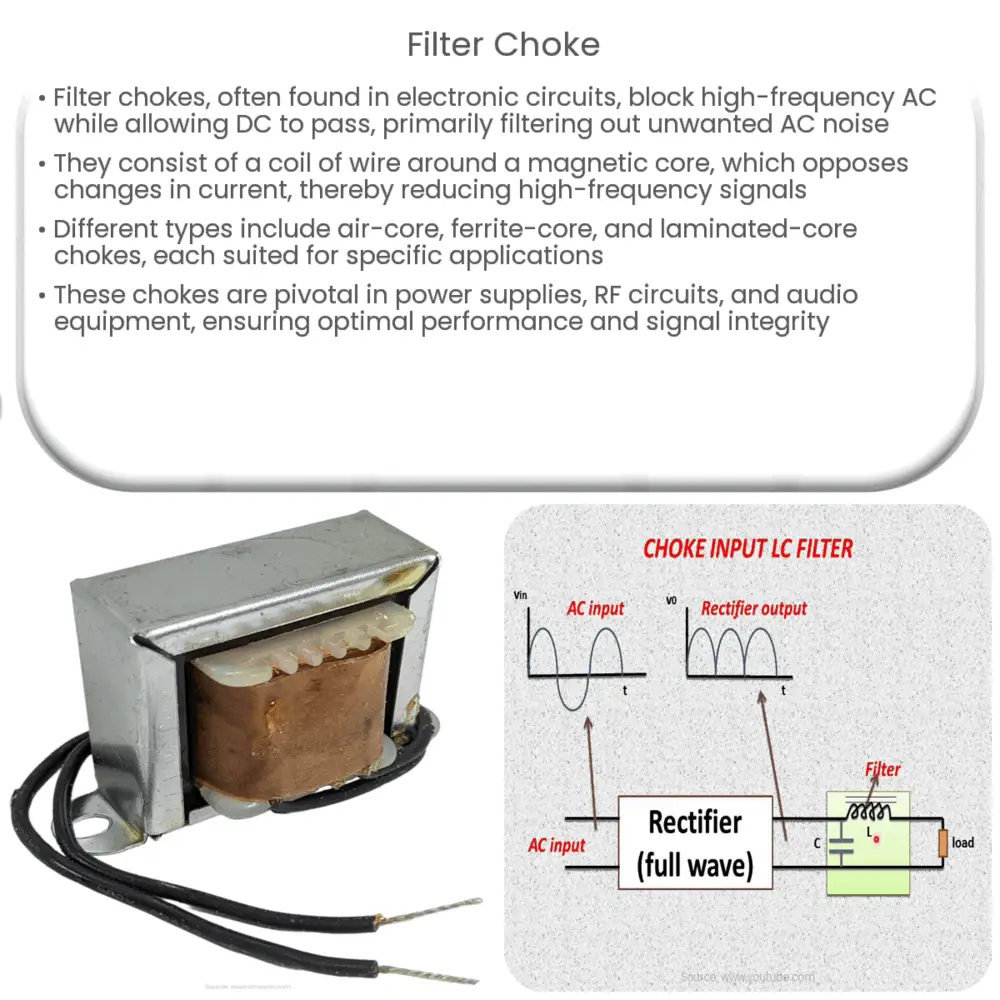A filter choke is an electronic component that blocks high-frequency AC noise while allowing DC to pass through, ensuring signal integrity in circuits.

Understanding Filter Chokes: Basics and Applications
Introduction to Filter Chokes
Filter chokes, also known as inductor chokes or simply chokes, are essential components in electronic circuits that serve to block high-frequency alternating current (AC) while allowing direct current (DC) to pass through. They are typically employed in power supplies and radio frequency (RF) circuits to filter out unwanted AC noise, ensuring that only the desired signals are transmitted. This article provides an overview of filter chokes, how they work, and their various applications.
Basic Principle of Filter Chokes
Filter chokes are passive electronic components that consist of a coil of wire wrapped around a magnetic core. When a current passes through the coil, it generates a magnetic field around it. This magnetic field opposes any changes in the current, thus creating an inductive reactance which increases with the frequency of the AC signal. As a result, filter chokes exhibit higher impedance to high-frequency AC signals, effectively reducing or blocking them from passing through.
The ability of a filter choke to block AC signals is measured in henries (H), which represent the inductance of the component. The higher the inductance, the better the choke is at filtering out high-frequency noise. However, it is important to strike a balance between inductance and physical size, as larger filter chokes can be more difficult to incorporate into compact circuit designs.
Common Types of Filter Chokes
There are several types of filter chokes available, each with their own unique characteristics and applications. Some of the most common types include:
- Air-core chokes: These chokes do not have a magnetic core and are simply composed of a coil of wire. Air-core chokes are lightweight and have low losses, making them suitable for high-frequency applications such as radio frequency (RF) circuits.
- Ferrite-core chokes: Ferrite-core chokes utilize a magnetic core made from a ferrite material, which provides higher inductance and improved filtering performance compared to air-core chokes. These chokes are often used in power supply applications and are effective at reducing electromagnetic interference (EMI).
- Laminated-core chokes: Laminated-core chokes feature a magnetic core made up of thin layers of iron or steel, which are insulated from one another to reduce eddy current losses. These chokes are suitable for low-frequency applications and can handle high current loads.
Applications of Filter Chokes
Filter chokes have a wide range of applications in various electronic systems, including:
- Power supplies: Chokes are often used in linear and switched-mode power supplies to filter out high-frequency noise and provide a stable DC output voltage. This ensures the proper functioning of sensitive electronic components and reduces the risk of system malfunctions.
- Radio frequency (RF) circuits: In RF circuits, filter chokes are employed to block unwanted high-frequency signals and interference, allowing only the desired frequency range to pass through. This is essential for maintaining signal integrity and preventing distortion in communication systems.
- Audio equipment: Chokes can also be found in audio amplifiers and other audio equipment to minimize high-frequency noise, which can otherwise cause distortion or signal degradation.
Selecting the Right Filter Choke
When choosing a filter choke for a specific application, there are several factors to consider:
- Inductance: Select a choke with an appropriate inductance value for the desired level of filtering. Higher inductance values provide better filtering performance but may result in larger and heavier chokes.
- Frequency range: Ensure the choke is designed to operate within the frequency range of the application. For instance, air-core chokes are better suited for high-frequency applications, while laminated-core chokes are ideal for low-frequency applications.
- Current handling capacity: Choose a choke that can handle the maximum current expected in the circuit without overheating or causing performance issues.
- Size and weight constraints: Consider the physical dimensions of the choke and how it will fit within the overall design of the circuit. Smaller, lighter chokes may be more desirable for compact applications, but they may not provide the same level of performance as larger, heavier chokes.
Maintaining Filter Chokes
Proper maintenance of filter chokes is essential for ensuring optimal performance and longevity. Some general maintenance tips include:
- Regular inspection: Periodically check filter chokes for signs of wear, such as cracked or damaged insulation, loose connections, or other visible damage. Address any issues promptly to prevent further deterioration or failure.
- Cleaning: Keep filter chokes clean and free of dust, dirt, and debris that can accumulate over time and impede their performance. Use a soft brush or compressed air to gently clean the chokes as needed.
- Temperature monitoring: Monitor the temperature of filter chokes during operation to ensure they are not overheating, which can lead to premature failure. If a choke is consistently running too hot, consider replacing it with a higher-rated component or improving the cooling system within the circuit.
Conclusion
Filter chokes play a crucial role in electronic circuits by blocking unwanted high-frequency noise and allowing only the desired signals to pass through. By understanding the basic principles, types, and applications of filter chokes, as well as how to select and maintain them, engineers and hobbyists alike can ensure the reliability and performance of their electronic systems. Whether used in power supplies, radio frequency circuits, or audio equipment, filter chokes are an indispensable component in modern electronics.

